Sunswift in the World Solar Challenge, 2009
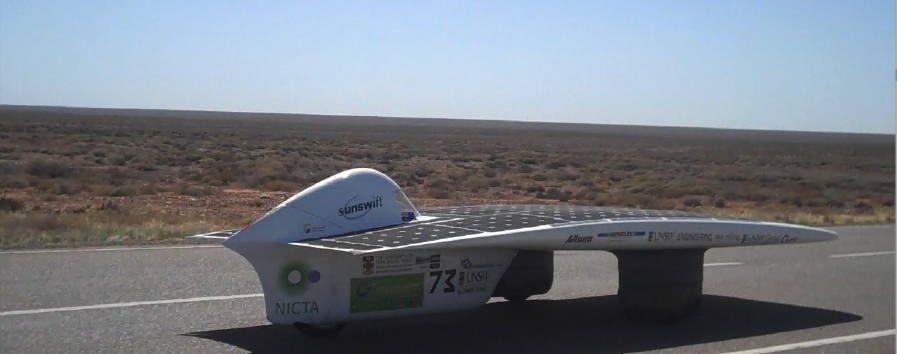
Trials Day 1 Day 2 Day 3 Day 4 Day 5 Celebration
The final trials and scrutineering in the World Solar Challenge take place at the Hidden Valley Racetrack outside of Darwin before the race to Adelaide. It is odd but wonderful to see the cars come speeding down the straight and to pass with a whir of air and electrics that one can only hear if the support team is not cheering.


Over 30 teams are set up in the workshops by the pit lane. Bochum of Germany is on one side of us with their Bocruiser, the Technical University of Istanbul has a sleek looking car on the other. Nuna from Delft is considered the team to beat because of their recent wins and the evident size of the support, but there are several fast cars on the track. The atmosphere is very positive and there is great camaraderie. Teams lend each other equipment and assistance.
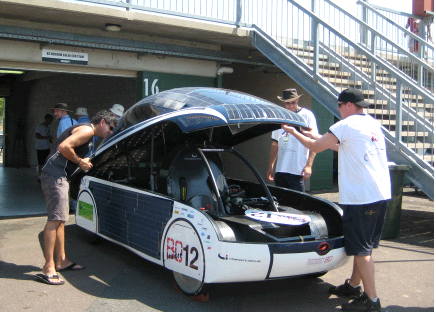

The teams range from several Australian high school entries through to fully professional racing teams. Univ Michigan is reported to have complained that the global financial crisis had hurt their sponsorship and that they had only M$ 3.1 for this campaign. They have brought a big yellow semitrailer containing a workshop equipped with lathe, mill etc... and a machinist.

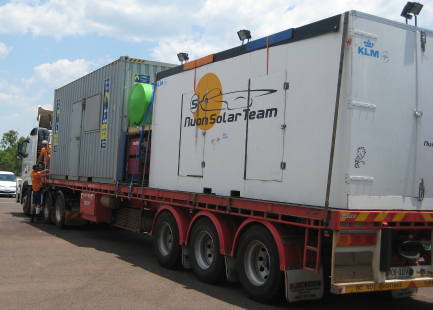
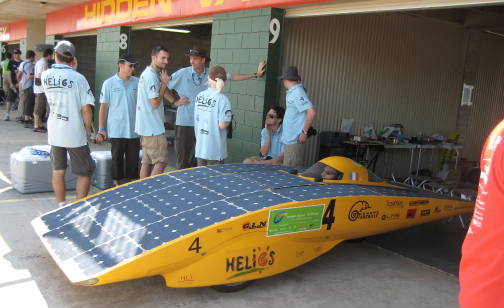
The big divide is between silicon solar cells and the more efficient but much more expensive gallium arsenide cells. Only seven or eight teams can afford the several hundreds of k$ for gallium arsenide. Hence there are two different classes in the race. (There is also a special class for older cars dating from before the rule changes reduced the permitted array size from 8 to 6 square metres.)
sUNSWift is in silicon class of course: the car is designed and built by students. At 164 kg, the car is towards the light end of the race, and she possibly has one of the best aerodynamic performances. So if all goes well, including teamwork, she should be very competitive in the silicon class, but she can't hope to compete with the power advantage conferred by the gallium arsenide cells.
The team is running rather late, still making changes and repairs late on the eve of the race. They don't have a lot of training time, and especially not a lot of sustained time on the road at high speed. There have been a few reliability issues, too. Which is a worry for me because, as the academic staff member present, I have the responsibility to make final decisions, on behalf of the uni, on how hard or even whether we race. Car racing on public roads is inherently dangerous and there has been one death in Canada, though happily none in this event. My role, as a colleague put it, is to take the blame if things go wrong and, if things go very wrong, to phone the parents and to give evidence to the coroner. But to enjoy it if goes well.
Ivy qualifies and will be seventh on the grid. From my point of view, the good news was that we had the best result of all cars in the braking trial (reportedly 4.5 m from 35 km/hr), and were very good in the chicanes.
For the race, we self-impose a speed limit of 80 km for the first two hours. This is to be revised later on advice from the driver and the performance of the car on the road, particularly with regard to its reliability and handling. This decision was only taken reluctantly, however, because the optimum strategy is to use the full battery charge allowed at the start of the race to leave Darwin at high speed, taking advantage of the 130 kph speed limit, both to get out from below the coastal clouds and to avoid being overtaken by other cars on later grid positions. Ivy's top speed is around 115 kph.
The race leaves Darwin on Sunday morning with a band and a big crowd. As each solar car pulls on to the road, it is joined by its fleet. A scout car travels a few km ahead, warning of conditions, clearing obstacles and scouting for camp sites. The lead vehicle travels 500 m ahead, calling oncoming traffic and road conditions on the CB radio. This includes announcing the 96 cattle grids on the way. The control car is close behind the solar car, protecting it from following traffic. All fleet cars have flashing lights and warning signs. We have a ute pulling a big trailer that can carry the solar car, but also has the camping gear. Another car, called cavalry, has more support crew.

sUNSWift has an unfortunate incident soon after the start. The driver's pod in IVy is narrow and uncomfortable and the driver had to sit in the car for over an hour before the start. Soon after the start, she became uncomfortable, reporting pins and needles in her leg. At a traffic light, she was unable to push the foot brake pedal hard enough and the solar car collided with the trailer towed by the Sunswift lead vehicle. No-one was hurt and the car continued. The car had run a metre or so under the trailer, scarring the array and damaging some cells.
Further, the driver still had the symptoms so, soon after, the car pulled over for a driver change. During the changeover, the control panel was damaged. This was replaced with a spare. Unfortunately, this took 30 minutes or so, during which time most of the race overtook us. As it happens, neither driver feels confident to drive above 80 km/hr for the first two hours, so the self-imposed speed limit makes no difference. After two hours without further incident, and with the car proceeding stably and without incident, the speed limit is removed. Modifications to the seating position are made at stops and at the end of the day.
So we begin the slow process of overtaking the field, including some very slow cars, usually waiting for overtaking lanes. The overtaking fleet switches channels to that of the fleet being overtaken and it goes smoothly, with all looking out for on-coming traffic. On the first day, we overtake most of the field – we especially enjoy passing Cambridge. We finish the day in 9th place, but the distance covered (about 400 km) is disappointing.
The race goes from 8 am to 5 pm, with a number of compulsory 10 and 30 minute control stops along the way. One can also stop for driver changes and for repairs, but that time is counted in elapsed time. Our drivers, Clara (also project manager when not racing) and Alex (who also looks after and characterises the battery pack) have impressive stamina and good control of their hydration: they make the distance between checkpoints, which in one case is four hours. They wear cold vests and have ‘camel packs’ to drink from. They wear a throat microphone to talk to the fleet. The controls, including cruise control, are located on the small steering wheel, looking somewhat like a play station. Both drivers carry ballast to make 80 kg.
At the end of the day, one can drive as late as 10 minutes past 5, but that delays the start to 10 past 8. So, between 4:50 and 5:10, we look for places to stop that have low horizons and no trees East and West. Ideally on top of a hill, but there are few of those between Darwin and Adelaide. The car charges well on the road between 11 am and 1 pm: sometimes we get over 1000 W from the array: about the power of a hair dryer or an electric jug. When the sun is low, we get much less, of course. Unless we are stopped: From 5 pm to sunset and from dawn to 8 am we take the 'lid' off the car and orient the array at right angles to the sun. The lead car tows a smaller trailer with a jig that can hold it in place. So at 5:10 we stop at a place that is a bit clearer than the surroundings and, while some of us position the array, others get the swags and cooking gear out of the trailer. The mechanical team begins its check of the car and the electrical team is still working on the array, trying to optimise it following the accident. Others are putting new tires on wheels, to minimise the chance of blow-outs. Others go to bed early to be ready at 5 am to position the array for the first light from the sun: the evening and morning charge give us a substantial fraction of our energy.

Control is an 8-seater people mover. The driver is also the controller, giving instructions to the solar driver and coordinating communications with the fleet. Jono and Etienne take turns in this highly skilled role and are both extraordinarily calm under pressure. Next to the driver is an official observer from the race organisation, who takes notes and times, who locks the battery up at night, and who paints a line on the road to record where we stopped. In the next row of seats are representatives of the electrical and mechanical teams, ready to leap out in case of problems. Often this includes Cam or Luke, who have had large roles in mechanical design and construction. In the back row is a desk with a couple of computers. The battery voltage, the currents out of battery and the different parts of the array, power to motors, temperatures and tire pressures are all displayed here. Dave has made a sophisticated program to determine the optimum speed, taking into account the state of charge of the battery, current and predicted cloud and wind, and topography.

I should mention Arthur, who, with Caitlin, drives the ute with the big trailer, a total of 4.5 tonnes. Arthur is a retired NRMA road officer and great value to the team. He correctly diagnosed a damaged wheel bearing and put a limit of 90 psi on tire pressures, which may have a role in our good luck with tires.

As 8:10 am approaches, we begin a countdown, getting everything ready. The array is pointing at the sun until the last possible moment, then attached to the car. Then we are all off, rolling across the largely flat country.
Sparse sclerophyll forrest continues across the North of the Territory, but we are rarely shaded by trees. The slopes are gentle, and we have 1500 km to ascend the 600 m to the highest point on the Sturt Highway.
Away from Darwin, there are no more passing lanes. There is not much traffic, but a substantial fraction of it is road trains. Most have a prime mover and four wagons, a total of 82 to 86 wheels. The largest are up to 200 tonnes and 53 metres long. In the Northern Territory, they travel at speeds up to the legal limit of 130 kph. Overtaking is interesting, but made much easier by CB radio. It takes them a while to accelerate and to pass, but our lead or scout vehicle can warn of traffic and there is no shortage of straight flat sections of road. They are all on channel 40, but when they approach us from behind, they switch to our channel, which is marked on all vehicles. Interestingly, they all seem to have the same truckie accent. "Gee, she gets along, doesn't she?" drawls the first, as he passes IVy.


There have been a couple of small problems today: the spats are fairings around the two front wheels. To minimise weight, they are made of rather thin carbon fibre reinforced plastic, and so are flexible. In a strong cross wind, they rub on the tires, which could be dangerous if it wears the tire, and is also a waste of energy. Spat modifications continue over the first few days.
Our camp at the end of day 2 is near Karlu Karlu (the Devil's Marbles). We are happier to have made about 600 km today and have moved into seventh place. We were happy to pass Stanford, but also sombre, having passed the wreckage of the Belgian car, Umicore. This car blew a tire at over 100 km/hr, left the road and hit a tree. The car was destroyed but happily the driver was unhurt. Umicore had twice suffered suspension damage and a suspension rebuild in the final testing at Hidden Valley, which might have contributed to the accident, because Umicore was reported to have awkward handling. Two other teams, Twente from Netherlands and Aurora from Victoria both had blowouts, which resulted in serious mechanical damage, but were able to be to repaired and both continued after repairs.

Kulgera checkpoint provides a new observer, who is pleased to have left the Japanese team, because host teams are responsible for feeding the observer, and this one doesn’t like Japanese camping food.
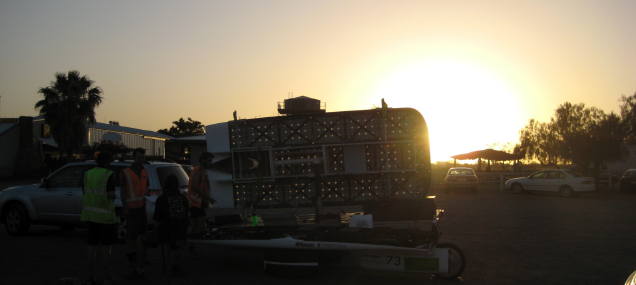
The third day takes us through Alice Springs, the first time I have been to this town. It’s a 30 minute check point. My half-hour consists of dropping the crew from Lead to help with the array, then driving to a service station for fuel and to check the tires of car and trailer. On return, I have time for a toilet stop, and to check the route out of town and to pick up the crew. Then we are on the roadside, ready to go. Yes, it would be good, one day, to drive this road as a tourist, but it is exciting to do it as a race. There has been no listening to music on this trip, and relatively little chat. We are concentrating on traffic, road conditions and the radio communications in the fleet. Regularly, Dave gives us status reports from his telemetry desk in Control. Now that the race is going well, we occasionally have reports of excitement levels in the vehicles of the fleet. It's pretty high.
As one approaches the South Australian border, a large sign announces that it is illegal to bring fruit into the state (so as to limit the spread of fruit fly). A quick check: our car's food box still has a dozen apples and we don't have time to stop at the promised bin for disposal. What to do? Well, there are four of us in the car. That takes care of lunch.
In the afternoon, there is a 42 km section of straight, level road. It has very little traffic. This is fortunate, because this is where we catch up to Principia College. This is not named in honour of Isaac Newton: it is an American religious university, which has enough money for gallium arsenide cells. It also has a large support team and prayer meetings every morning. With a relative speed of less than 10 kph, it takes a while to overtake them. Once again, however, with scout, lead and trailer calling traffic from both directions, slow overtaking is safe.

Twente is the other Dutch team. Their car looks very cool: it has a tilting array, so can gather more power on the road in early morning and late afternoon. It also has a big budget and the expensive GaAs cells. But they have a blow-out and roll the car. Good news: not only does the driver walk away, but the array is undamaged. They manage to repair the suspension and to finish the race. We pass their improvised workshop on the side of the road. That’s not a good way to move into fifth place overall.
At each checkpoint Irving notes the arrival times of the cars ahead of us. We start the day about 90 minutes behind MIT, which is the only silicon car ahead of us. The UNSW’s director of services, Neil Morris, has been a fan of the team and provided support. He wanted to know whether we would beat MIT. Well, we’ve passed Cambridge and Stanford and things are going well. Each checkpoint brings us closer. Can our luck hold out?
Coober Pedy is a 30 minute stop. (Okay, I know, it’s also an underground town and the centre of the opal industry, it’s a very interesting place! But that’s for another trip.) Because the stop is next to a service station, we have a bit more time here. We pull in 4 minutes behind MIT. After refueling, I bring the lead car and trailer to a carpark just beyond the checkpoint to wait for the fleet. MIT has a wheel change to do, and rules prohibit working on the car during a control stop. Jono thinks that we shall therefore overtake them while they are doing the change, which would obviate the slow manœuvre on the road. When they leave the stop, they pull up for the change at the edge of a carpark, where I am waiting with the lead car and trailer. Before the car arrives, I help the MIT crew sweep loose gravel away from the verge – it’s that sort of race, and gravel is a safety issue because of the number of tire blowouts in this event. Then I start shooting a movie of their very slick wheel change. But before the change is finished, control calls me to pull out onto the roadside, ready to go: it looks as though we are going to leave first. However, to our considerable surprise, they manage the change in three minutes, which means that they pull out a minute ahead of us. Now it really feels like a race.
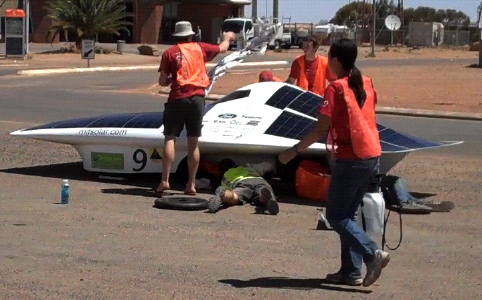
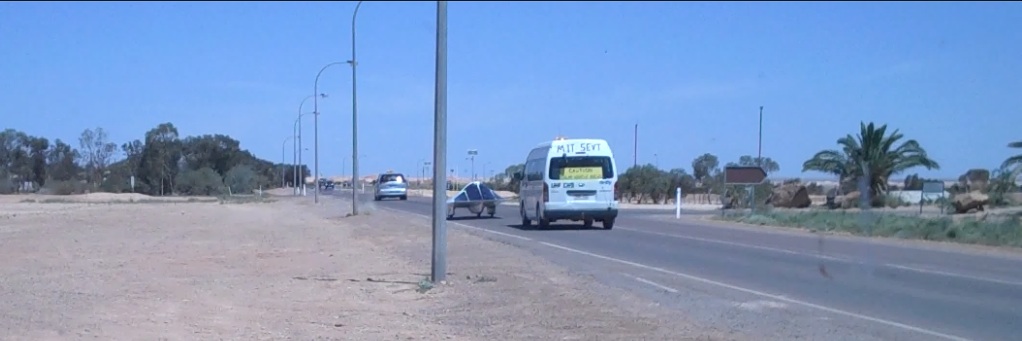
Between Alice and Coober Pedy, our scout and the race time records had MIT at about 70-75 kph, while we’ve been making well over 80. So we are surprised that it takes over half an hour to catch them and, when we do, they are varying between 75 and 80, with no obvious correlation with the gentle slopes of the road. We shift to their channel and request permission for the overtaking manœuvre. They agree, but then there is complete silence. Later Arthur reports seeing a second antenna on their car: everyone is obliged to have CB, but they seem to have another radio for covert communications: they can hear us, but not vice versa. There are regular straight sections, the traffic is not heavy, and we have long forewarning. Nevertheless, it takes time to get scout and lead past their fleet.
Eventually, we hear control’s order: “Solar car, move right, target speed 91 kph”.

This is a big moment for Sunswift, because there are two races going on – the gallium arsenide and silicon divisions. We are now fourth overall, but we are the first silicon-powered car. As well as the highly efficient gallium arsenide cells, the three cars still ahead of us all have multi-million dollar budgets and professional staff.
MIT is presumably still listening in when Dave gives the status report: the sun is well past zenith, but we are only drawing about 200 W from the battery, and the battery voltage and estimated energy are good. The strategy is to keep the speed high until 5 pm, because we’ll get a good charge tonight and tomorrow morning: these are needed for the expected (light) cloud and (slight) hills coming into Adelaide. Someone calls for an excitement report. “Woo-hoo” from Alex in solar car sums it up for all of us.
We later find out that MIT have flattened their battery in the attempt to hold us off. Consequently, they have to spend the last hour travelling on power from the low-angle sun alone. This puts them some kilometres behind us.
Good news: we make the control stop at Glendambo, 600 km N of Adelaide, just before 5 pm. Glendambo is a pub, a service station, some cabins and a camping ground for us. It’s flat and there are few trees – we’ll get good charges. Further, there are showers and toilets and even telephone reception – luxury camping! Daniel exhorts everyone not to relax, and the teams go through their checks and put new tires on. But the running improvements are coming to an end, and by 10 pm most of the jobs are done. I notice a few people sitting around with laptops. There is a Telstra tower near here: could someone in the team be geeky enough to carry a wifi link and local antenna on the control vehicle? Silly question, really. So I join the group and email a report to a few friends and to various people on campus. (Having contact to the outside world for the first time in a few days, I discover that colleague John and I have won an ARC grant, which will help keep the lab productive over the next few years, so I go to sleep very happy indeed.)
Alex reports that some of the battery cells are behaving oddly, and there is the danger that they will overcharge. They are bypassed for safety. The start goes smoothly. One of our sponsors is The Weather Zone, one of whose people is following the race with a couple of friends in a campervan. He gives us regular forecasts, and for today we have light cloud (about 80% sun) and – good news – a tail wind to replace the cross-headwind we've had so far.
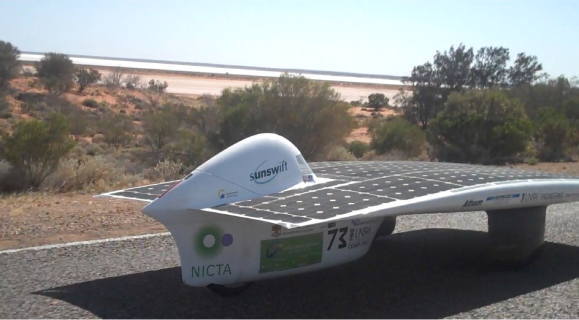
I’m in the scout car this day and have the job of dragging a recently killed kangaroo and bits of road-train tires off the road so that IVy doesn’t have to drive over them. If all goes well, we’ll finish today. The last timing point is Angle Vale, on the outskirts of Adelaide (to avoid racing in the city). However, because of the rush hour, if we arrive after 3pm, we’ll have to wait until the morning to do the ceremonial arrival in central Adelaide. It requires that we average 87.5 kph, which is possible with the good charge and the tailwind. Just after noon, South of Port Augusta, we are doing 96 kph on sun alone, with no battery input, and 101 with only 80 W from the battery. But there is disappointment. Twice we get stuck behind road-trains which (in SA at least) are speed limited to 85. And there is lots of traffic. Worse, there are road works and, at one stage, the speed limit is 25 kph. Add this to the usual speed restrictions in towns… we arrive at the finish line (the last timing point) at 3:08 pm.

The team is ecstatic and there is lots of leaping and shouting – movie here. We've crossed the continent in less than 5 days: 3021 km in 39 hours. Even including the terrible first day, IVy has averaged over 76 kph on the power of a hairdryer. She is placed fourth, behind Tokai University of Japan, Nuna and Michigan: all teams with very big budgets. More importantly, IVy has won the silicon division – and is ahead of several GaAs cars. She is also the first Australian car and this is the best finish by the Sunswift team ever. Results are here.
We spend the night in cabins in a caravan park in Adelaide: there are not only toilets and showers, but a swimming pool. We are in danger of getting soft. Further, Adelaide has cold showers, a luxury that Darwin and Glendambo couldn't offer. We have an early start to go back out to Angle Vale to drive the car in to Victoria Square.
We park the fleet a km away from the centre where race marshalls take IVy and the support crew is invited to board a solar bus. (No, the bus doesn’t carry its own array. The rational way to have solar vehicles is to put the arrays on the roofs of buildings and to charge up the batteries when needed wherever one stops. Cars like IVy are a nice symbol, but it is impractical to carry a significant array with you. What solar cars teach is some features of how to make rational cars. The sad fact is that, when designing cars, most designers look at last year’s car and think how to improve it. What they should do is to look instead at a bicycle. A few simple rules, such as charging heavy fees for the entry of all private metropolitan vehicles over, say, 300 kg, could rapidly lead to rational traffic and liveable cities.)

Celebrations follow. Some jump into the fountain, others are thrown in. The ‘others’ include officials and friends of the team – and this correspondent. Crates of beer and bottles of champagne mysteriously appear. Photos are taken, official details are checked, and IVy proudly takes her place in the line of finishers.
During the day, several other cars arrive: MIT, Aurora, Principia, Twente and Bochum’s faster car. A number of others reach Port Augusta before the six-day time limit runs out: the Bocruiser, Stanford University , Goko High School, Helios. All these can claim to have crossed the continent in less than six days. A number of cars are stretched out behind along the Stuart Highway: Solarshop (A combined Oz high school car), Nanyang (Singapore), Belenos (France), Endeavour (Cambridge University), Saguar (Turkey), Heliox (Switzerland), Ariba (our neighbours from Istabul), Komilda High School, Leeming High School (Darwin), Willeton High School (WA), three Canadian cars and two Malaysian cars. The wreckage of Umicore has been trailered in and makes a sobering reminder of the dangers.
Another event has been combined with the solar event. In a classic example of greenwashing, a number of conventional and less conventional cars are driven across the country aiming to conserve petrol. The ugliest of these, a V8 ute, is declared the winner: which means that, if you tune a hugely overpowered vehicle so lean that it only just runs, pump up the tires to high pressure and drive it at 75 kph with the windows up and no air-conditioning, you can get rather better economy than that claimed for normal driving. Whatever normal driving might mean for a fluorescent-green V8 ute that, despite its name, doesn't seem to be made for utility.
That evening, there is a quiet celebration. I had promised the Sunswift team that I’d buy a round of drinks if we arrived safely in Adelaide. On passing MIT, I doubled this. Considering the alternative, one could say that these were very cheap rounds.
The awards presentation is another occasion for celebration. Winners and place-getters are honoured, and the Sunswift team runs wildly onto the stage. Principia wins the safety award, and Nuna the ‘spirit of the race’ award. There is a ‘best newcomer’ award that goes to our neighbours from Istanbul Tech.
After the awards there’s a party at The Woolshed, a large Oz-themed pub. Some of the drinkers are in halloween costume. A couple of hundred racers are here but we have all swapped shirts and it is hard to find identify teams. A good story: a member of the Michigan team confronts Nuna, to complain that a Nuna logo has inexplicably appeared on the huge Michigan trailer. Only sponsors are allowed to have their stickers on the trailer, he observes, and sponsors must pay for the privilege. How much? enquires Nuna. At least $1000. The Nuna bloke vanishes to find an ATM. He reappears with a handful of cash. There you are, Nuna is now a sponsor of Michigan! Well, this might have cost $1000. However, when you divide that into the number of laughs that this story has provoked, it’s quite a good bargain!

Teams in finishing order (challenge class)Day 4.
3rd. Michigan. 4th. Sunswift. First with silicon cells 5th. MIT. Second with silicon cells
7th. Principia. 8th. Twente. 9th. Bochum Solar World. 10th. Bochum Bocruiser. 11th. Stanford. Fourth with silicon cells |
External links World Solar Challenge
sUNSWift: UNSW's solar racing team
Joe Wolfe, School of Physics, 1/11/2009 |
NICTA Information and Communications Technology Centre of Excellence (Gold sponsor)
Sunshine n Water (Gold sponsor)
UNSW Faculty of Engineering (Gold sponsor)
Altium Limited electronics (Silver sponsor)
B2B networking (Silver sponsor)
Benelec Pty. Ltd Communications (Silver sponsor)
Gurit composite materials (Silver sponsor)
Mo Milling CNC machining (Silver sponsor)
The Weather Company (Silver sponsor)
School of Photvoltaics and Renewable Energy Engineering (Silver sponsor)
UNSW School of Computer Science and Engineering (Silver sponsor)
Hallmark Edition event management (Silver sponsor)
The UNSW U-committee (bronze sponsor)
Tritium motor controllers (bronze sponsor)
Revolectrix lithium batteries (bronze sponsor)
MouldCam moulding (bronze sponsor)
Immij printers (bronze sponsor)
Mirvac Group safety equipment (bronze sponsor)
Gochermann Solar Technology arrays (bronze sponsor)
RS technical components (bronze sponsor)
Knox Grammar School (bronze sponsor)
Telstra 3G network coverage (bronze sponsor)
CSG solar module producer (bronze sponsor)
Lease Plan (supporter)
Akubra (supporter)
Engraved (supporter)